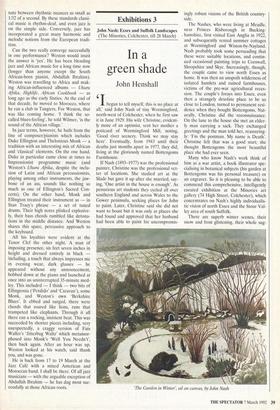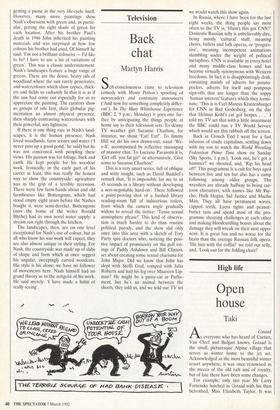Exhibitions 3
John Nash: Essex and Suffolk Landscapes (The Minories, Colchester, till 28 March)
In a green shade
John Henshall
Ibegan to tell myself, this is no place at all,' said John Nash of tiny Wormingford, north-west of Colchester, when he first saw it in June 1929. His wife Christine, evident- ly more of an optimist, sent her mother a postcard of Wormingford Mill, noting, 'Good river scenery. Think we may stay here'. Eventually, from 1943 until their deaths just months apart in 1977, they did, living at the gloriously named Bottengoms Farmhouse.
If Nash (1893-1977) was the professional painter, Christine was the professional vet- ter of locations. She studied art at the Slade but gave it up after she married, say- ing, 'One artist in the house is enough'. As penurious art students they cycled all over southern England and across Wales to the Gower peninsula, seeking places for John to paint. Later, Christine said she did not want to boast but it was only at places she had found and approved that her husband had been able to paint his uncompromis- ingly robust visions of the British country- side.
The Nashes, who were living at Meadle, near Princes Risborough in Bucking- . hamshire, first visited East Anglia in 1922, and subsequently rented summer cottages at Wormingford and Wiston-by-Nayland. Nash probably took some persuading that these were suitable locations, and contin- ued occasional painting trips to Cornwall, Shropshire and Skye. Increasingly, though, the couple came to view north Essex as home. It was then an unspoilt wilderness of isolated hamlets and ruined farmhouses, victims of the pre-war agricultural reces- sion. The couple's forays into Essex, even then a strangely desolate place to be so close to London, turned to permanent resi- dence when they bought Bottengoms. Nat- urally, Christine did the reconnaissance. On the lane to the house she met an elder- ly man carrying a sack. They exchanged greetings and the man told her, reassuring- ly: 'I'm the postman. My name is Death'. Christine felt that was a good start; she thought Bottengoms the most beautiful place she had ever seen.
Many who know Nash's work think of him as a war artist, a book illustrator spe- cialising in botanical subjects (his garden at Bottengoms was his personal treasure) or an engraver. So it is pleasing to be able to commend this comprehensive, intelligently curated exhibition at the Minories art gallery (74 High Street, Colchester), which concentrates on Nash's highly individualis- tic vision of north Essex and the Stour Val- ley area of south Suffolk.
There are superb winter scenes, their snow and frost glistening, their whole sug- 'The Garden in Winter', oil on canvas, by John Nash gesting a pause in the very life-cycle itself. However, many more paintings show Nash's obsession with green and, in partic- ular, getting the right shade of green for each location. After his brother Paul's death in 1946 John inherited his painting materials and was surprised at how few colours his brother had used. Of himself he said: 'I'm not a brilliant colourist — I'd like to be! I have to use a lot of variations of green'. This was a classic understatement. Nash's landscapes feature a huge range of greens. There are the dense, heavy oils of woodland where the sun rarely penetrates, and watercolours which show copses, thick- ets and fields so radiantly lit that it is as if the sun had come out especially for us to appreciate the painting. The curators show us groups of oils first, their globular pig- mentation an almost physical presence, then sharply contrasting watercolours with their powerful, airy lightness.
If there is one thing rare in Nash's land- scapes, it is the human presence. Nash loved woodlands, farm scenes and water (`I never pass up a good pond,' he said) but he was not concerned with peopling these views. His passion was for foliage, bark and earth. He kept people for his woodcut work. Ironically, in the early part of his career at least, this was really the honest way to show the countryside: agriculture was in the grip of a terrible recession. There were few farm-hands about and old farmhouses like Bottengoms, which had stood empty eight years before the Nashes bought it, were semi-derelict. Bottengoms (now the home of the writer Ronald Blythe) had its own novel water supply: a stream ran right through the kitchen.
The landscapes, then, are on one level exceptional for Nash's use of colour, but as all who know his war work will expect, they are also almost unique in their styling. For Nash, the countryside was made up of slabs of shape and form which at once suggest his angular, sweepingly carved woodcuts. His style is his alone; we have no follower of movements here. Nash himself had no grand theory as to the zeitgeist of his work. He said merely: 'I have made a habit of really seeing'.



















































 Previous page
Previous page